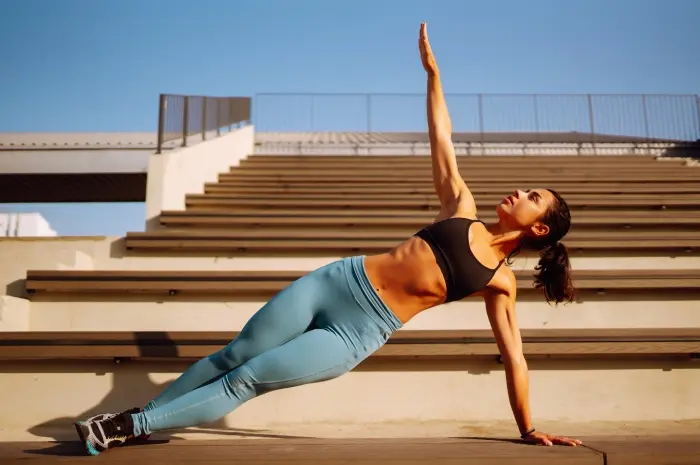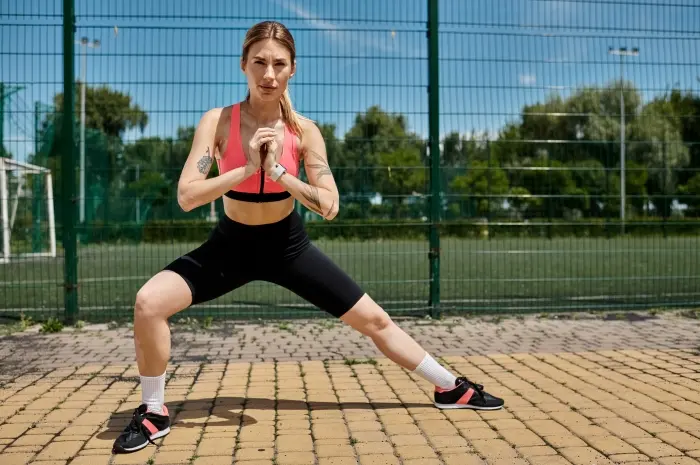Running is a fantastic cardiovascular exercise that offers numerous health benefits, from improved heart health to enhanced mental well-being.
However, to maximize performance and reduce the risk of injury, incorporating strength training into your routine is essential.
Strength training exercises for runners can improve muscle balance, increase power, and enhance overall running efficiency. By building a strong, resilient body, you can run faster, longer, and with less risk of injury.
Whether you’re a seasoned marathoner or a casual jogger, adding specific strength training exercises to your workout regimen can make a significant difference.
This article highlights the 11 best strength training exercises for runners, focusing on exercises that target key muscle groups, improve stability, and support your running form.
These exercises are designed to complement your running routine and help you achieve your fitness goals more effectively.
1. Squats
Benefits
Squats are fundamental strength training exercises for runners. They target the quadriceps, hamstrings, glutes, and calves, which are essential for running power and stability.
How to Do It
Stand with your feet shoulder-width apart. Lower your body by bending your knees and hips, keeping your back straight and chest up.
Push through your heels to return to the starting position. Aim for 3 sets of 12-15 repetitions.
2. Lunges
Benefits
Lunges improve balance, coordination, and strengthen the quadriceps, hamstrings, and glutes. They also enhance hip flexibility, which is crucial for runners.
How to Do It
Step forward with one leg, lowering your hips until both knees are bent at about a 90-degree angle.
Keep your front knee over your ankle and your back knee just above the ground. Push back to the starting position and switch legs. Perform 3 sets of 10-12 repetitions per leg.
3. Deadlifts
Benefits
Deadlifts strengthen the posterior chain, including the hamstrings, glutes, and lower back. This exercise improves overall stability and power, essential for running efficiency.
How to Do It
Stand with your feet hip-width apart, holding a barbell or dumbbells in front of you. Bend at the hips and knees, lowering the weights while keeping your back straight.
Return to standing by driving through your heels and extending your hips. Aim for 3 sets of 8-10 repetitions.
4. Calf Raises
Benefits
Strong calves are vital for absorbing impact and propelling you forward while running. Calf raises help build strength and endurance in these muscles.
How to Do It
Stand with your feet shoulder-width apart. Slowly raise your heels off the ground, standing on your toes, then lower back down.
To increase difficulty, perform on a step or with added weight. Do 3 sets of 15-20 repetitions.
5. Plank
Benefits
A strong core is crucial for maintaining proper running form and preventing injury. Planks target the abdominal muscles, lower back, and shoulders.
How to Do It
Lie face down on the floor, then lift your body onto your forearms and toes, keeping your body in a straight line.
Hold this position, engaging your core, for 30-60 seconds. Repeat for 3 sets.
6. Side Plank

Benefits
Side planks enhance lateral stability and strengthen the obliques, hips, and shoulders. This exercise is essential for balanced core strength.
How to Do It
Lie on your side with your legs stacked and lift your body onto your forearm, keeping your body in a straight line. Hold for 30-45 seconds on each side. Perform 3 sets.
7. Glute Bridges
Benefits
Glute bridges activate and strengthen the glutes and hamstrings, improving hip stability and power in your stride.
How to Do It
Lie on your back with your knees bent and feet flat on the floor. Lift your hips towards the ceiling, squeezing your glutes at the top.
Lower back down and repeat. Do 3 sets of 15 repetitions.
8. Single-Leg Deadlifts
Benefits
Single-leg deadlifts enhance balance, coordination, and strength in the hamstrings, glutes, and lower back. They are particularly effective for correcting muscle imbalances.
How to Do It
Stand on one leg, holding a weight in the opposite hand. Hinge at the hips, lowering the weight towards the ground while extending the other leg behind you. Return to the starting position and repeat. Perform 3 sets of 10 repetitions per leg.
9. Step-Ups
Benefits
Step-ups target the quadriceps, hamstrings, and glutes, simulating the motion of running uphill and improving overall leg strength.
How to Do It
Stand in front of a bench or step. Step up with one leg, driving through your heel, then bring the other leg up to meet it.
Step back down and repeat. Perform 3 sets of 12-15 repetitions per leg.
10. Russian Twists
Benefits
Russian twists strengthen the obliques and improve rotational stability, which is important for maintaining balance and form while running.
How to Do It
Sit on the floor with your knees bent and feet off the ground. Lean back slightly and hold a weight or medicine ball.
Rotate your torso to the left, then to the right, tapping the weight on the floor each time. Perform 3 sets of 15-20 repetitions.
11. Hip Thrusts
Benefits
Hip thrusts are excellent for building glute strength, which is crucial for generating power and stability in your running stride.
How to Do It
Sit on the ground with your upper back against a bench, knees bent, and feet flat on the floor.
Place a weight across your hips and lift your hips towards the ceiling, squeezing your glutes at the top. Lower back down and repeat. Do 3 sets of 12 repetitions.
Conclusion
Incorporating these strength training exercises for runners into your routine can lead to significant improvements in your running performance and overall fitness.
By targeting key muscle groups and enhancing stability, these exercises help build a strong foundation that supports efficient and injury-free running.
Make strength training a regular part of your workout regimen to achieve your running goals and enjoy a healthier, more balanced body.











